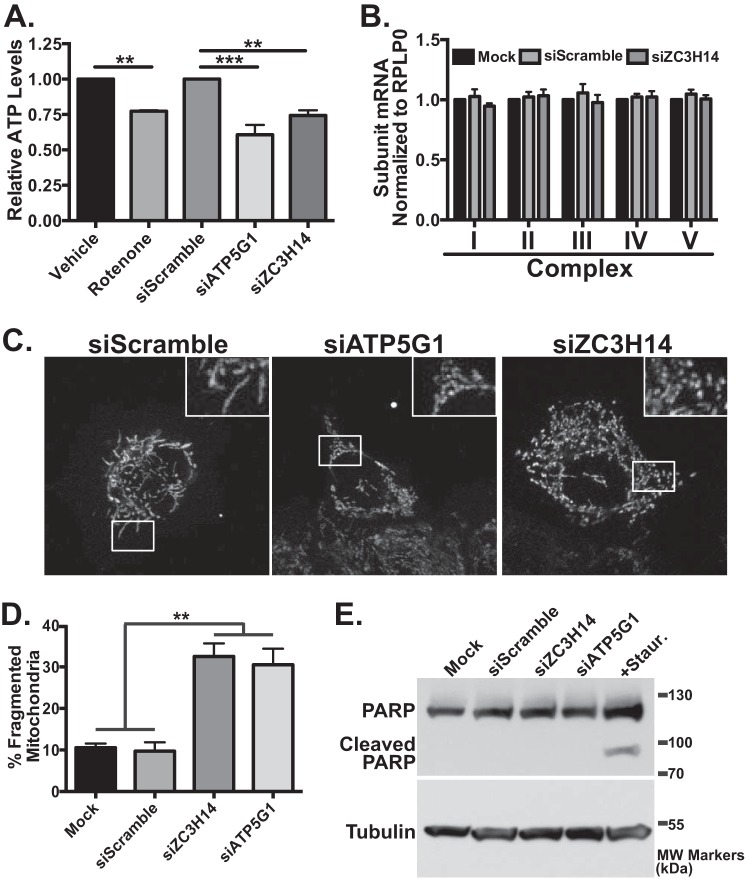FIGURE 7.
Knockdown of ZC3H14 results in fragmented mitochondria. A, to assess cellular ATP levels, cells treated with vehicle control, the electron transport chain inhibitor, rotenone, Scramble siRNA, or siRNA targeting ATP5G1 or ZC3H14 were subjected to boiling water extraction and ATP level quantification using a luciferase-based assay. Cellular ATP levels are normalized to vehicle control or siScramble, which are both set to 1.0 and plotted as relative ATP levels. ZC3H14 knockdown results in decreased cellular ATP levels similar to that observed with rotenone treatment or knockdown of ATP5G1. B, cells treated with a mock transfection, Scramble siRNA, or ZC3H14 siRNA were harvested, and total RNA was used for qRT-PCR analyses. Primers specific to one representative nuclear-encoded mitochondrial mRNA from each OXPHOS complex as well as the control transcript, RPLP0, were used to assess any overall impact of ZC3H14 knockdown on steady-state levels of transcripts encoding OXPHOS components I, NDUFA4; II, SDHB; III, UQCRFS1; IV, CoxIV, and V, ATP5B (67). Relative mRNA values for each OXPHOS mRNA from mock transfection are set to 1.0. C, MCF-7 cells transfected with either Scramble (siScramble), ATP5G1 siRNA (siATP5G1), or ZC3H14 (siZC3H14) were fixed, permeabilized, and subjected to immunofluorescence with cytochrome c antibody. Insets are enlarged from the boxed regions of cells to better highlight mitochondrial morphology. Mitochondrial morphology in cells transfected with scrambled siRNA was indistinguishable from cells transfected with no siRNA (data not shown). D, cells from C were scored for the presence of normal or fragmented mitochondria. Data are represented as a mean averaged from three independent experiments (n = 304 for mock transfected cells, 311 for scrambled siRNA, 307 for ZC3H14 siRNA, and 307 for ATP5G1 siRNA). The difference between control cells treated with Scramble siRNA and either ZC3H14 or ATP5G1 siRNA-treated cells was statistically significant. E, MCF-7 cells treated with mock transfection, Scramble, ZC3H14, or ATP5G1 siRNA or the apoptotic inducer staurosporine (Staur.) were subjected to immunoblot analysis with PARP or tubulin antibody. The presence of cleaved PARP product only in the staurosporine-treated samples suggests that the other cell populations are not undergoing apoptosis. Values represent the mean ± S.E. for n = 3 independent experiments. ** represents p ≤ 0.01; ***, p ≤ 0.01. Images are representative of n = 3 independent experiments with at least 100 cells per experiment in each treatment group.

